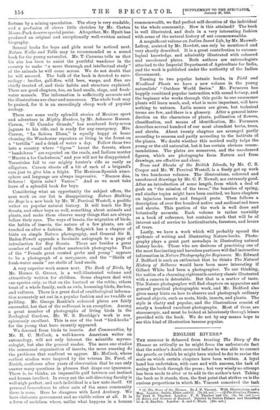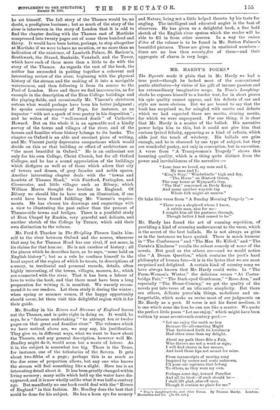ENGLISH RIVERS.*
THE reviewer is debarred from treating The Story of the Thames as critically as he might from the unfortunate fact that the author's death occurred before he was able to correct the proofs, or (which he might have wished to do) to revise the scale on which certain chapters have been written. A loyal hand has undertaken, with care and with success, the task of seeing the book through the press ; but very wisely no attempt has been made to alter or to add to the author's text. Taking the book as it stands, then, the first point that strikes us is the curious proportions in which Mr. Vincent conceived the task
* (1) The Story of the Thames. By J. E. Vincent. With Illustrations and a Map. London Smith, Elder, and Co. [7s. Bd. net.]—(2) The Stripling Thames. By Fred S. Thacker. London F. S. Thacker and Co. [8s. 6d. net.3— (3) Rivers and Streams of England. Painted by Sutton Palmer and Described by A. G. Bradley. London: A. and C. Black. [20s. net.]
he set himself. The full story of the Thames would be, no doubt, a prodigious business ; but so much of the story of the river is interwoven in the story of London that it is odd to find the chapter dealing with the Thames east of Mortlake compressed into twenty pages out of some three hundred and thirty. It would have been better, perhaps, to stop altogether at Mortlake if we were to have no mention, or no more than an indication of the existence, of Lambeth Palace, St. Saviour's, Southwark, the Strand, Bankside, Vauxhall, and the Tower, which have each of them more than a little to do with the story of the Thames. As regards the rest of the book, the author has succeeded in putting together a coherent and interesting review of the river, beginning with the physical history of the stream and the making of it into a navigable watercourse, and then following it from its source to the Pool of London. Here and there we find inaccuracies, as for example in the description of the Eton College buildings and the playing-fields, and occasionally Mr. Vincent's strictures outrun what would perhaps have been his better judgment ; he speaks contemptuously of Pope, for instance, as an impostor "with not a spark of true poetry in his disposition"; and he writes of the "well-earned death" of Catherine Howard. But on the whole it is an agreeable and a kindly survey of the towns and villages of the river, and of the houses and families whose history belongs to its banks. The chapter on Oxford is an able and succinct piece of writing, and Mr. Vincent justly deprecates comparisons which would decide on this or that building or effect of architecture as "the most beautiful in Oxford." He is an enthusiast not only for his own College, Christ Church, but for all Oxford Colleges, and he has a sound appreciation of the buildings which disfigure as well as of those which adorn that city of towers and domes, of grey façades and noble spaces. Another interesting chapter deals with the "towns and hamlets of Thames Head," with Fairford, Faringdon, and Cirencester, and little villages such as Bibury, which William Morris thought the loveliest in England. Of Bibury we should like to have seen an illustration, if one could have been found fulfilling Mr. Vincent's require- ments. He has chosen his drawings and engravings with a view to illustrating the past rather than the present of Thames-side towns and bridges. There is a youthful study of Eton Chapel by Ruskin, very graceful and delicate, and another sketch of the College by Turner, which add their own distinction to the volume.
Mr. Fred S. Thacker in The Stripling Thames limits him- self to the river between Oxford and the source, wherever that may be, for Thames Head has one rival, if not more, in its claims for that honour. He is not careless of history ; all the places which he describes have, as he says, "some hold on English history "; but as a rule he confines himself to the local aspect of the region of which he treats, to descriptions of scenery, to _territorial and personal records, details, often highly interesting, of the towns, villages, manors, &c., which are connected with the river. That it has been a labour of love to write the book, and that there must have been a long preparation for writing it, is manifest. We warmly recom- mend it to our readers. Let them study it during the winter ; when spring or summer comes, if the happy opportunity should occur, let them visit this delightful region with it for their guide.
Mr. Bradley in his Rivers and Streams of England leaves out the Thames, and is quite right in doing so. It would, he says, be a "fatuous undertaking" "to attempt ten or twelve pages on that great and familiar river." The volumes which we have noticed above are, we may say, his justification. They give us, in different ways, what we want to know about the Thames, and any general description, however well Mr. Bradley might do it, would seem but a waste of labour. As it is, the subject is somewhat too big. There is the Teme, for instance, one of the tributaries of the Severn. It gets about two-fifths of a page ; perhaps this is as much as the due sense of proportion allows, but any one who knows the stream will feel something like a slight. Here too is an interesting detail about it. It has been greatly changed within living memory ; many mills which held up the water have dis- appeared, and it is now wholly unlike what it was half -a-century ago. Bat manifestly no one book could deal with the " Rivers of England" in this fashion. Mr. Bradley does the best that could be done for his subject. He has a keen eye for scenery and Nature, being not a little helped thereto by his taste for angling. The intelligent and educated angler is the best of observers. He has given us a delightful book, a fine bold sketch of the English river system which the reader will be able to fill in from other sources. In a way the raison d'etre of the volume is to be found in Mr. Sutton Palmer's beautiful pictures. These are given in unstinted numbers— there are no less than seventy-five of them—and their aggregate of charm is very large.























































 Previous page
Previous page